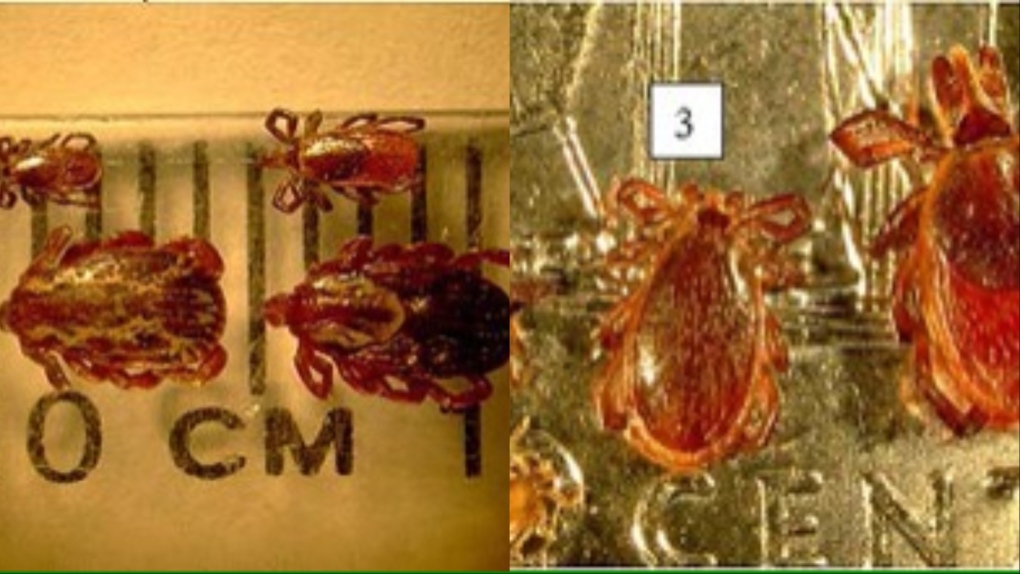At least 60 reports of Lyme disease so far as Ontario enters tick season
Peak tick season is only just beginning but reports of bites – and tick-borne illnesses – are already higher than normal in Ontario.
Ontario is home to 13 established species of ticks, with dozens more reported across the province. The insects, found year-round, are most active in the summer months, when temperatures stay above 0 C. While not all ticks carry infectious agents, and not everyone who is bitten by an infected tick will develop symptoms of disease, a bite can expose humans to an array of health concerns, including Lyme disease.
So far this year, at least 1,124 sightings of blacklegged ticks, the species most likely to transmit disease, have been reported in Ontario. Just over 600 of those were found on humans, according to eTick.ca, the primary public reporting platform for monitoring ticks across Canada.
Reports made to the platform have been increasing since it launched in 2014. Five years ago, in 2019, the organization received just over 120 reports of blacklegged ticks in Ontario over the same timeframe.
While there isn’t usually much activity on the platform prior to April, this year “people and [their] pets have been encountering ticks in parts of southern Ontario and a few spots in eastern Ontario in December and January,” Associate Professor Manisha Kulkarni with the University of Ottawa’s School of Epidemiology and Public Health said in a media release.
Kulkarni said Ontario has seen a continued expansion of the species in Canada, with more regions, such as Ontario, Quebec, and the Atlantic provinces, reaching the endemic stage.
Historically in Ontario, blacklegged ticks were found only in cooler areas, near the shores of the Great Lakes. But according to the most recent map of established risk areas, the insects can now be found many miles inland and more and more often, in urban and residential areas.
“Unfortunately, these areas are often close to where people live or which is used for recreation, allowing more human tick exposures in residential settings and people’s own yards,” Kulkarni said.

The warming climate and subsequent expansion has caused a significant spike in tick-borne illnesses – in the last decade, the number of cases of Lyme disease in Canada has increased by 1,000 per cent, according to government statistics.
Lyme disease symptoms occur in stages. Often, the affliction first presents as a red bump or rash around the site of a tick bite. In later stages, those with Lyme disease can develop joint issues, nerve pain, dizziness, headaches, heart palpitations, memory issues and more. In very rare cases, it can be fatal.
From 2018 to 2021, more than 8,000 Canadians were diagnosed with the disease.
According to provincial data, there have been 60 reports of Lyme disease in Ontario so far this year. The average year-to-date is 43.
How to prevent tick bites
According to TickTOOL, an educational resource compiled by the University of Montreal and eTick, the best way to prevent Lyme disease is to avoid tick bites altogether.
Wearing long pants, socks, and closed-toe shoes while outdoors can help avoid a bite. Light-coloured clothing can also make ticks easier to spot, if they end up on you.
The resource also recommends applying bug spray containing one of the two ingredients for tick protection recommended and authorized in Canada, DEET and Icaridin.
While you’re outdoors, watch where you walk, the resource says. Ticks are found in long grasses or vegetation, especially along trails, so if you’re heading outdoors, it’s important to be mindful of your environment and prepare accordingly – and don’t forget to reapply bug repellent.
How to spot a tick
Blacklegged ticks are small – the nymphs are about the size of a poppy seed and the adult females, the size of a sesame seed – making them easy to miss when checking yourself and your pets after an outdoor outing. The males are even smaller.
If they’ve fed, however, they can swell significantly – with adult females reaching up to 10 mm in length.
The species ranges in colour, appearing brown or black, with spots of crimson near the abdomen.

You may not notice a tick bite because ticks are tiny and their bites are usually painless.
Once coming home from outdoors, check your clothes, gear, and pets for ticks before going inside. TickTOOL advises particular attention to shoes, socks and pants. It then advises placing your clothing in the dryer on high heat for at least 10 minutes. Ticks die in dry conditions, not hot ones, so using a washing machine is not effective, it says.
When inspecting your skin, look for dark or discoloured spots and use your hands to feel for small bumps.
How to remove a tick
If you find a tick on your body, you will need it carefully removed. Health Canada has an educational video that instructs on how to remove a tick properly, which can be viewed here.
With clean, fine-point tweezers, start by grasping the tick at the head, as close to the skin as possible, the agency advises.
“Take your time and slowly pull it straight out. Try not to twist or squeeze the tick.”
Being in a well-lit area or using a magnifying glass may help you to see better, the guide says. If you are not comfortable removing a tick or cannot reach it yourself, ask another person to help you as soon as possible. Once it has been removed, clean the area with soap and water, or alcohol solution.
“Be aware that those various ‘home remedies’ you may have heard for tick removal have not been proven effective and can potentially do more harm than good,” the agency said on its website. “Under no circumstances should a flame, ointment, flammable liquid (gasoline, oil, lighter fluid, acetone, nail polish, etc.) or caustic material be used in removal attempts.”
Monitoring for symptoms of tick-borne illnesses
Generally, a tick must have been attached to a body for 24 hours or more to transmit Lyme disease. Still, it is recommended to monitor for symptoms even if the tick has been removed in less time.
Signs and symptoms of Lyme disease can vary from person to person. Early symptoms may include fever, headache, muscle and joint pain, fatigue and an expanding red rash, often bullseye-shaped with a ring around it.
In July 2023, the Ministry of Health designated tick-borne illnesses as reportable diseases of public significance, requiring public health units to enter case information about all individuals into the integrated Public Health Information System within one business day of initial notification.
CTVNews.ca Top Stories

Trump threatens to try to take back the Panama Canal. Panama's president balks at the suggestion
Donald Trump suggested Sunday that his new administration could try to regain control of the Panama Canal that the United States “foolishly” ceded to its Central American ally, contending that shippers are charged “ridiculous” fees to pass through the vital transportation channel linking the Atlantic and Pacific Oceans.
Wrongfully convicted N.B. man has mixed feelings since exoneration
Robert Mailman, 76, was exonerated on Jan. 4 of a 1983 murder for which he and his friend Walter Gillespie served lengthy prison terms.
opinion Christmas movies for people who don't like Christmas movies
The holidays can bring up a whole gamut of emotions, not just love and goodwill. So CTV film critic Richard Crouse offers up a list of Christmas movies for people who might not enjoy traditional Christmas movies.
Can the Governor General do what Pierre Poilievre is asking? This expert says no
A historically difficult week for Prime Minister Justin Trudeau and his Liberal government ended with a renewed push from Conservative Leader Pierre Poilievre to topple this government – this time in the form a letter to the Governor General.
New York City police investigate death of woman found on fire in subway car
New York City Police on Sunday were seeking a man they believe is connected to the early morning death of a woman who was sleeping on a stationary subway train before she was intentionally lit on fire.
More than 7,000 Jeep SUVs recalled in Canada over camera display concern
A software issue potentially affecting the rearview camera display in select Jeep Wagoneer and Grand Cherokee models has prompted a recall of more than 7,000 vehicles.
'I'm still thinking pinch me': lost puppy reunited with family after five years
After almost five years of searching and never giving up hope, the Tuffin family received the best Christmas gift they could have hoped for: being reunited with their long-lost puppy.
10 hospitalized after suspected carbon monoxide poisoning in Ottawa's east end
The Ottawa Police Service says ten people were taken to hospital, with one of them in life-threatening condition, after being exposed to suspected carbon monoxide in the neighbourhood of Vanier on Sunday morning.
Pickup truck driver killed by police after driving through Texas mall and injuring 5
A pickup truck driver fleeing police careened through the doors of a JCPenney store in Texas and continued through a busy mall, injuring five people before he was fatally shot by officers, authorities said.


































